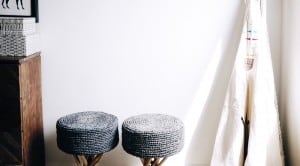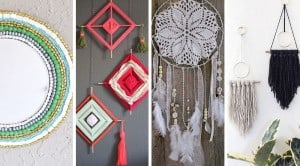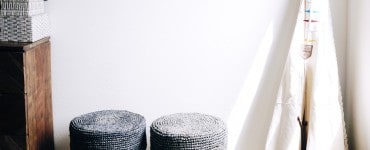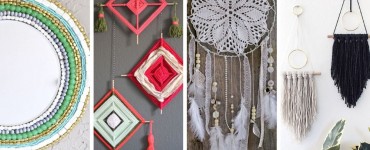If there is ever a interior design style that combines effortless with chic, it would be Bohemian. Where everything from crochet to tassels to wicker to wood can work, it is understandably the favorite of many. Inspired by the gypsies of Bohemia, the style gained popularity as a fashion in the 60’s and 70’s. It’s representing free thought and taking a break from the mainstream culture.
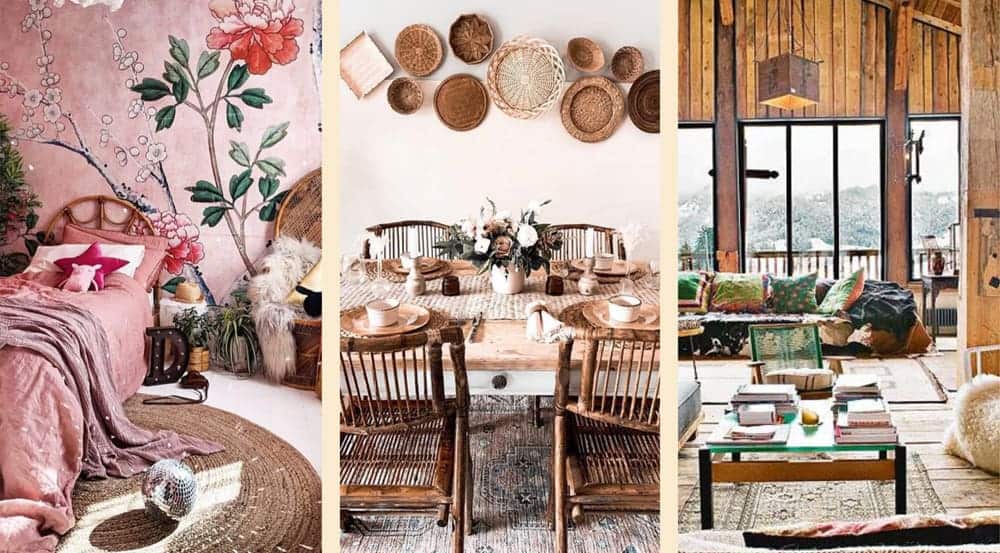
Free flowing dresses and mismatched clothes based on the nomadic lifestyle of the Balkan gypsies were among some of the most noticeable elements.
When the bohemian style entered interiors, it followed the same ideals, creating an environment that mixes and matches what is available to create a natural style that follows not much of norms.
It is more about the originality than the rules, which makes it stand out from the other styles and makes every space unique to the creator.
What Is Bohemian Interior Design
Bohemian interior design tries to capture the carefree lifestyle that it is coined after.
The term comes from the French word “bohémien” which loosely refers to the Romani people (erroneously called gypsies) who are known to be nomadic wanderers. It eventually came to loosely refer to people who adapt the same eclectic lifestyle. Ergo, this design concept reflects that and does not necessarily adhere to strict rules. In fact, it delights in pushing boundaries and comfort zones.
Due to this, it highly appeals to a more creative and artistic sensibility. Those who are drawn to incorporate a more personal approach to design opt for this style because of all the opportunities available to explore in putting the key elements together.
It is a style that celebrates what it means to be alive, by incorporating natural elements, vintage pieces, vibrant colors, varying textures and patterns. These all come together in a way that offers an unconventional aesthetic, yet still retains a cohesive feel to it.
History of Bohemian Interior Design
This design originated from a movement in 19th century Paris. It was adopted by artists who moved into “gypsy” neighborhoods due to the lower rent in these areas.
They left behind the confines of the conservative bourgeoisie and adhered to a more liberated lifestyle, which permeated into their craft, design, and choices. Living with the Romani, which they thought had come from Bohemia, they referred to their lifestyle as bohemian.
It saw various resurgences throughout the 20th century, predominantly during the 1960s at the height of the hippie movement. Appealing to the liberal mindset and prioritizing creative expression, people reflected a similar lifestyle of the 19th century bohemians.
The hippies then borrowed design ideas from them and the Romani people, infusing it with other styles from non-Western cultures – mostly Moroccan, African, Indian, and South American. This also included other cultures that celebrate colors, patterns, and textures.
All of these varying style sensibilities came together to form a unique aesthetic now collectively known as bohemian. It is rooted in self-expression and is opted for by creatives, across history, who enjoy life and individuality.
Characteristics of Bohemian Interior Design
While the key characteristic of bohemian interior design is its lack of rules, there are still common practices that can be followed to achieve the style. Rooted in a celebration of life, every piece chosen aims to enhance this sensibility.
Plants and natural elements are used to represent life itself. Vintage pieces with their own history, and travel finds reflective of a global culture are an homage to the nomadic lifestyle. Bold and vibrant bohemian colors are combined with rich patterns to create an instant visual narrative.
Varied textures allow a more tactile experience of the space. Layers applied through the use of decor – mainly through the presence of rugs, pillows, and textile pieces – further the visual narrative.
These usually complement low-lying furniture that bring people in the space closer to each other. It allows those who experience the space to commune, thus, celebrate life, too.
All of these elements come together in a maximalist approach that evokes a sense of adventure and whimsy, rooted in individuality.
However, despite the lack of rules, below are a few design characteristics synonymous with bohemian interiors.
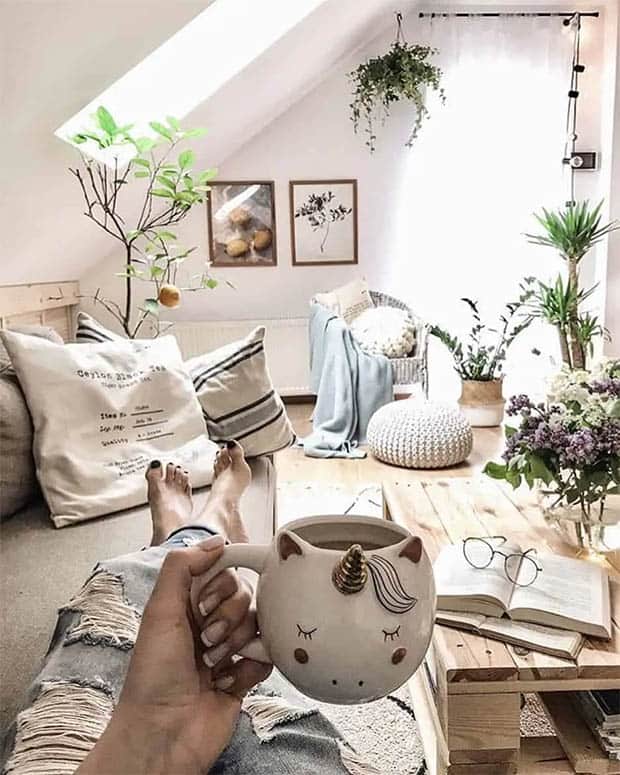
Patterns
A bohemian style space will have patterns, and lots of it. Be it a vintage rug or a wall hanging, patterns are an integral part of the design. It adds vibrance to the room and keeps it from being monotonous. Moroccan, Aztec or even Indian prints can be right at home here, given the correct balance. For those looking to start small, some of the easiest methods to introduce patterns into the room are through throw pillows, artworks and wallpapers.
Antiques/ Vintage IItems
The beauty of bohemian is visible from its ability to blend in old and vintage, even when they are worn out. True to the gypsy style, antique pieces and even unfinished furniture add to the character of the rooms.
Flea market finds , hand me downs and handmade wooden pieces can create interesting focal points without diminishing the other elements. Paired with indoor plants, these can easily become conversation starters.
Natural Materials
Natural materials are widely used in bohemian style, as are natural colors. So while materials like wood and wicker are mainstay, so are the materials from boho fashion, such as cotton, leather and linen. This also lends to the prominence of natural color schemes, like browns, yellows, ochres and reds. Indoor and outdoor plants in the design can be utilised to bring about green into the overall warm color palette , furthering the natural look.
Layers
Layering is used to bring depth into a space. Layers of rugs and throws can be used to bring about more colors and style into the room, while also creating spaces that are about more than what meets the eye, revealing more on a closer look. The variety of texture this brings about is also a plus for rooms that are more pared down.
By now, we’ve covered the most important elements of bohemian interior design . We have also discussed how some of these elements can be applied. However, at this point, you may still be having some trouble in figuring out how to best use these elements in your own space. Some people wonder if bohemian chic is an interior ideal that can be achieved in virtually any space.
The answer to that question is a resounding yes. With that in mind, we have assembled some of our favorite tips for bringing your boho dream to life in just about any space imaginable. Regardless of your budget, or your specific tastes, we’re confident you can find design inspiration and decor tips that will realize whatever you may have in mind.
Some of our tips will cover the elements of bohemian style we’ve discussed. At the same time, we’re also going to help you break new ground on rooms or eclectic spaces that are giving you some trouble.
Define Your Favorite Elements
Take another look through the elements we’ve discussed thus far, including the value of style and antique/vintage items. Remember that you don’t need to check every box on the essential bohemian interior decor elements checklist. There are certain things that should almost certainly be part of your plans, but remember at the end of the day that you can ultimately define bohemian design in your own way.
After all, antiques come in a variety of different forms, shapes, sizes, and more. There are tons of different ways to combine coziness with that pleasant, rolling lived-in feel. Those are two of the cornerstones of this boho style, but that doesn’t mean their particulars are actually set in stone.
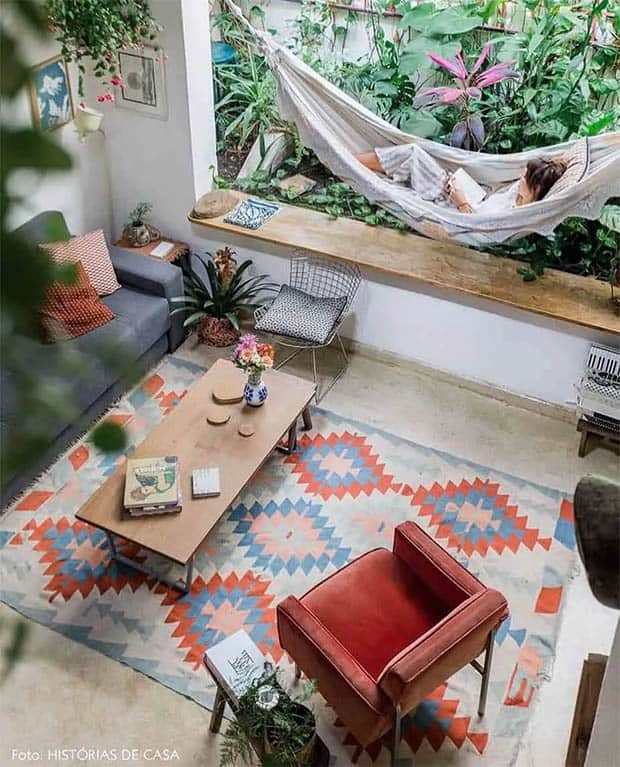
Be Open-Minded
At the same time, there is also something to be said for appreciating the heart and soul of this interior design type: Creativity. There is a certain art, it could be argued, to unlocking the type of creativity that will help you to create the boho look you have in mind.
Bohemian is essentially the idea of creating something comfortable, even inviting, without going overboard on elements like luxury. Of course, you want to and should be comfortable, but remember where bohemian comes from in the first place. It was a style developed initially by people who had to travel, and create a sense of home and self with a minimal of resources. This meant doubling down on what they had, among other traits. There is a creativity inherent in doing a lot with a little that you should definitely aspire to keep in mind.
In other ways, try to be open-minded in how you create your bohemian space.
Learn How To Mix And Match
A good example of what we’re talking about here lies in the idea of mixing and matching bohemian furniture styles, as a means of creating your own perfect bohemian concept. The bohemian lifestyle, at its core, is the lifestyle of a vagabond. Either term requires a certain amount of flexibility. You don’t want everything to match, when it comes to bohemian interior design ideas.
Bohemian is a great opportunity to mix and match decor styles you like. You don’t have to make do with limited resources. You simply have to create the illusion that you did. Take that idea, and apply it to the different mix-and-match options that combine decor styles that can help contribute to your larger plans.
For example, some people like to add bohemian touches to a space that could be described as modern overall. Key bohemian textures like baskets, rugs made from natural fibers, or certain pieces of wood furniture can set your bohemian style up with a fantastic contrast of styles.
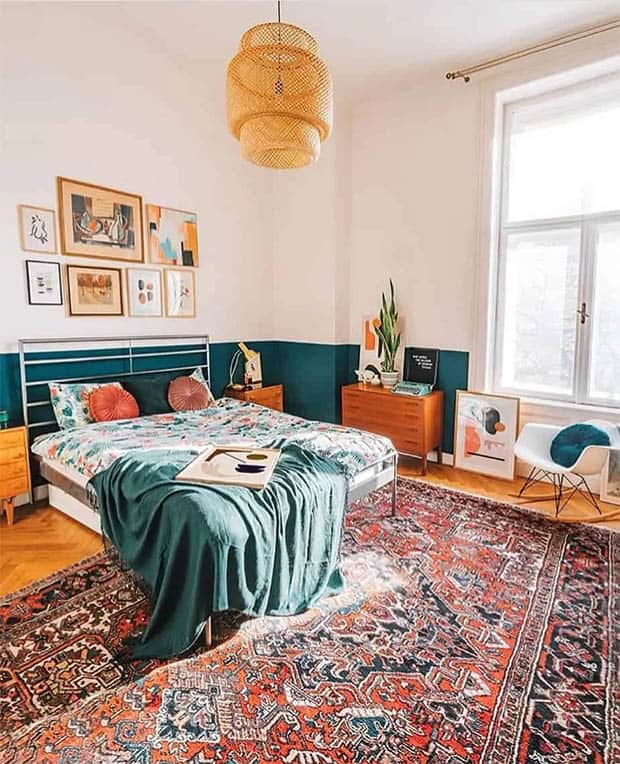
Think Bright And Organic
Rugs and carpets are great ways to add the bohemian ideal without too much hassle. Even a single brightly-colored emerald green rug in the middle of the living room can be a good start. If you want to take things a step further, add something that lends itself well to the subject of organic decor pieces. There are a range of pieces, including desks and lamps, which can work well in this arena.
You can also achieve this concept on rugs alone. A jute rug in one part of the room, with a more colorful rug established nearby in the same space. Put an antique desk (and perhaps one more antique decor item with jewel tones on top of that desk) over one of the rugs, or even between them, and you’ll have something quite spectacular.
Plan Your Use Of Bohemian Decorating Materials Carefully
Bohemian isn’t just about what you can use. It is also naturally going to include the elements you should avoid. This is particularly true when it comes to the decorative materials you’re planning to use.
Natural elements with a neutral color palette are always good to keep in mind with this design style. Hanging plants are a wonderful fixture of boho. Making the use of natural light is another good example of what we’re talking about.
While you can certainly bring bohemian elements to a modern space, you want to be careful that you aren’t also just adding more to the modern side of the equation. The idea is to avoid things that emphasize a minimal decor approach. There is using limited resources to create something inviting, and then there are decorative materials which create something that is sleek and decidedly far from the type of warm earthy tones bohemian is known for.
Bohemian is the opportunity to combine things like burlap and silk in a single room. It is also the chance to bring to your space materials and pieces that have that slightly-worn look and appeal.
Shop Around
These days, you can find bohemian-style decor furniture and materials in a dizzying range of places. Companies are still manufacturing and releasing items under this style, but those options tend to be expensive for no other reason than they were recently released.
The truth of the matter is that you can find stuff in tons of places. You just have to be willing to go on a bit of an adventure, depending on how particular you are about what you want to create. Check out eBay, thrift stores, yard sales, and flea markets for stuff. If you can’t leave the house for one reason or another, you still have fantastic resources like Etsy and eBay.



